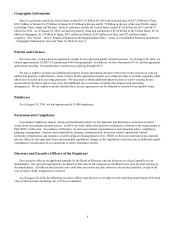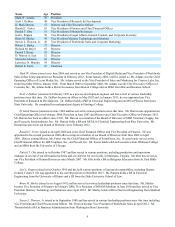Crucial 2014 Annual Report Download - page 19
Download and view the complete annual report
Please find page 19 of the 2014 Crucial annual report below. You can navigate through the pages in the report by either clicking on the pages listed below, or by using the keyword search tool below to find specific information within the annual report.17
Changes in foreign currency exchange rates could materially adversely affect our business, results of operations or
financial condition.
Across our multi-national operations, there are transactions and balances denominated in currencies other than the U.S.
dollar (our reporting currency), primarily the euro, the Singapore dollar, the New Taiwan dollar, the yen and the yuan. We
recorded net losses from changes in currency exchange rates of $28 million for 2014 and $229 million for 2013. Based on our
foreign currency exposures from monetary assets and liabilities, offset by balance sheet hedges, we estimate that a 10% adverse
change in exchange rates versus the U.S. dollar would result in losses of approximately $7 million as of August 28, 2014. In
addition, a significant portion of our manufacturing costs are denominated in foreign currencies. Exchange rates for some of
these currencies against the U.S. dollar, particularly the yen, have been volatile in recent periods. If these currencies strengthen
against the U.S. dollar, our manufacturing costs could significantly increase. In the event that the exchange rates for U.S. dollar
adversely change against our foreign currency exposures in the euro, Singapore dollar, New Taiwan dollar, the yen and the
yuan, our results of operations or financial condition may be adversely affected.
We may make future acquisitions and/or alliances, which involve numerous risks.
Acquisitions and the formation or operation of alliances, such as joint ventures and other partnering arrangements, involve
numerous risks including the following:
• integrating the operations, technologies and products of acquired or newly formed entities into our operations;
• increasing capital expenditures to upgrade and maintain facilities;
• increased debt levels;
• the assumption of unknown or underestimated liabilities;
• the use of cash to finance a transaction, which may reduce the availability of cash to fund working capital, capital
expenditures, research and development expenditures and other business activities;
• diverting management's attention from normal daily operations;
• managing larger or more complex operations and facilities and employees in separate and diverse geographic areas;
• hiring and retaining key employees;
• requirements imposed by governmental authorities in connection with the regulatory review of a transaction, which
may include, among other things, divestitures or restrictions on the conduct of our business or the acquired business;
• inability to realize synergies or other expected benefits;
• failure to maintain customer, vendor and other relationships;
• inadequacy or ineffectiveness of an acquired company's internal financial controls, disclosure controls and procedures,
and/or environmental, health and safety, anti-corruption, human resource, or other policies or practices; and
• impairment of acquired intangible assets and goodwill as a result of changing business conditions, technological
advancements or worse-than-expected performance of the acquired business.
In recent years, supply of memory products has significantly exceeded customer demand resulting in significant declines in
average selling prices for DRAM, NAND Flash and NOR Flash products. Resulting operating losses have led to the
deterioration in the financial condition of a number of industry participants, including the liquidation of Qimonda and the 2012
bankruptcy filing by Elpida (now known as MMJ). These types of proceedings often lead to court-directed processes involving
the sale of related businesses or assets. We believe the global memory industry is experiencing a period of consolidation as a
result of these market conditions and other factors, and we may engage in discussions regarding potential acquisitions and
similar opportunities arising out of these industry conditions. To the extent we are successful in completing any such
transactions, we could be subject to some or all of the risks described above, including the risks pertaining to funding,
assumption of liabilities, integration challenges and increases in debt that may accompany such transactions. Acquisitions of,
or alliances with, high-technology companies are inherently risky and may not be successful and may materially adversely
affect our business, results of operations or financial condition.
























